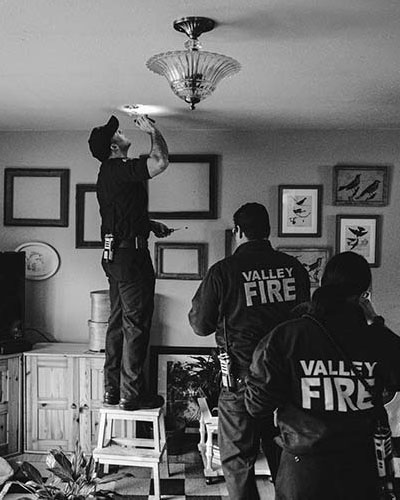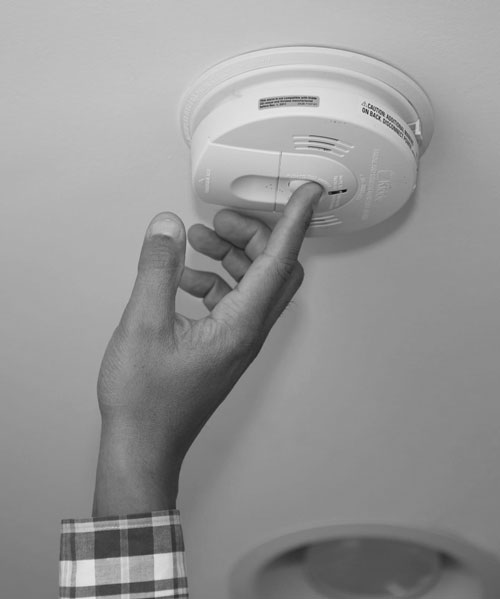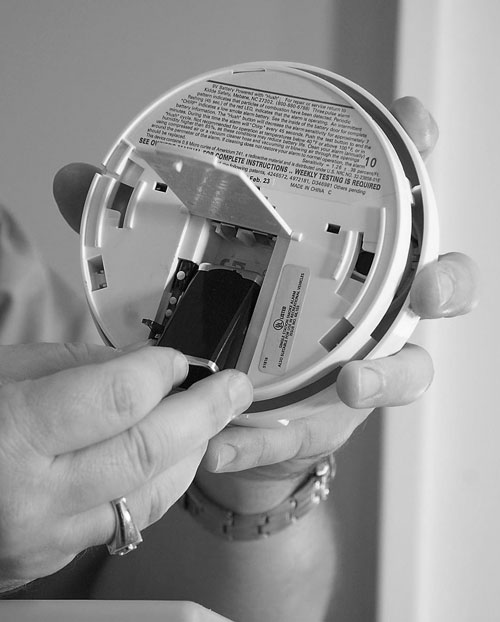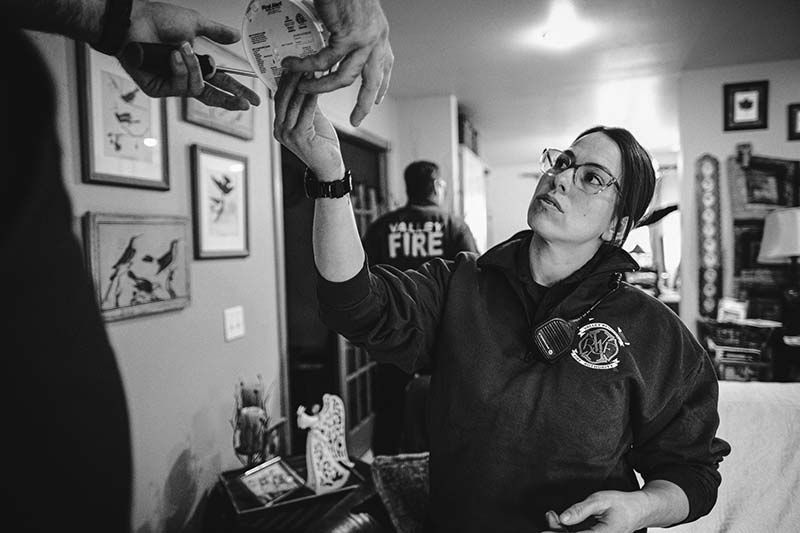Smoke Alarms & Devices
Working smoke alarms can increase your chance of surviving a fire in your home by 50%. Property owners are required to provide working smoke alarms and renters should test the alarms and change the batteries.

Follow manufacturer instructions
when installing alarms
- Ideally, smoke alarms should be installed inside and outside of every bedroom, and on each level of the home.
- If possible, install alarms than can be interconnected – meaning when one alarm sounds, they all will sound.
- Place smoke alarms on the ceiling or high on the wall. Check the manufacturer’s instructions for the best place for your alarm.
- Only qualified electricians should install hardwired smoke alarms.
- When purchasing alarms, be sure they are approved by a nationally recognized third party testing laboratory such as Underwriters Laboratory (UL) or Intertek (ETL).
- Install alarms with both photoelectric and ionization sensing technology. Photoelectric alarms are best for detecting smoldering fires and for false alarm prone areas (near kitchens and bathrooms). Ionization alarms are best at detecting flaming fires.
- Smoke alarms offer many different features including combination smoke and carbon monoxide alarms, talking alarms, units that are compatible with other home systems and cell phones, wired-in alarms, radio-frequency alarms, etc.
- Make sure your smoke and CO alarms meet the needs of all your family members, including those with sensory or physical disabilities. Smoke alarms and alert devices are available for people who are deaf or hard of hearing. These devices include strobe lights that flash to alert people when the smoke alarm sounds. Pillow or bed shakers designed to work with your smoke alarm also can be purchased and installed.
Know the sounds
of your smoke alarm
While some products may have slight differences, there are a few things everyone should know about the sounds smoke and CO alarms make:
- A continuous set of three loud beeps—beep, beep, beep—means smoke or fire. Get out, call 9-1-1, and stay out.
- A single chirp every 30 or 60 seconds means the battery is low and must be changed.
- All smoke alarms must be replaced after 10 years.
- Chirping that continues after the battery has been replaced means the alarm is at the end of its life, and the unit must be replaced.
- False alarms often occur when a smoke alarm is activated by cooking or shower steam. If this happens, move the alarm further from the kitchen or bathroom, or replace it with a photoelectric sensor alarm.
If your alarm is chirping due to a low battery or some other issue, it is extremely important to return the unit to full working order as soon as possible. Hearing a continuous chirp can lead some people to hesitate or ignore the warning sounds of an alarm when there is an actual emergency. Additionally, if the unit is faulty, it needs to be replaced as soon as possible.


Replace smoke alarm batteries annually
to avoid low battery "chirping"
- To replace the battery, unscrew the alarm from the mounting bracket, open the battery compartment, remove the old battery and insert a new one, checking to be sure the polarity (plus+ and minus- signs) are correct.
- Press the test button on the front of the alarm to be sure it works, then replace the alarm in the mounting bracket. Repeat this process for all alarms.
- When disposing of 9-volt batteries, be sure to cover the posts with electrical or masking tape and avoid placing them near any metal. Taking these steps can prevent a fire.
- Some “long life” smoke alarms utilize lithium batteries and the battery compartment is often sealed. When these chirp, the alarm is at the end of its life and needs to be replaced.
- Lithium batteries are recommended for alarms that are difficult to reach or access.
The Valley Regional Fire Authority can offer free replacement nine-volt batteries for smoke alarms; and free alarms in some cases. The batteries are supplied through a grant from the Energizer Company and the alarms from World Vision and Costco Corporation.
Contact us for available devices and return a completed smoke alarm application form to us.
Smoke Alarm
Maintenance
- Test your alarms monthly and change batteries once a year
- Vacuum or dust your alarms at least once a year to remove debris and keep sensors clear
- Never paint your smoke alarms or cover the alarms as this can block smoke sensors

Carbon Monoxide (CO) Alarms
Carbon monoxide (CO) is a poisonous gas that cannot be seen or smelled. It is produced by fuel burning appliances, fireplaces, and vehicles. The most common causes of CO poisoning are the indoor use of charcoal or gas grills and generators in garages or near air intakes.
- Carbon Monoxide (CO) alarms are required by RCW 19.27.530 to be installed in all new residences and existing rental properties.
- Locate CO alarms according to manufacturer instructions.
- CO alarms generally expire after 7 years and will notify that they need replaced with an "end-of-life" warning.
Carbon Monoxide Emergencies
If you feel sudden signs of CO poisoning such as dizziness, headache, vomiting, or flu-like symptoms go outside and call 9-1-1.
If your CO alarm alarms, move outdoors then call 9-1-1.
The VRFA will respond and use a monitoring device to sense CO levels in your home.
Home Fire Sprinklers
Because fire sprinklers react so quickly, they can dramatically reduce the heat, flames, and smoke produced in a fire. Properly installed and maintained fire sprinklers can control or extinguish fires before firefighters arrive, saving lives and property.